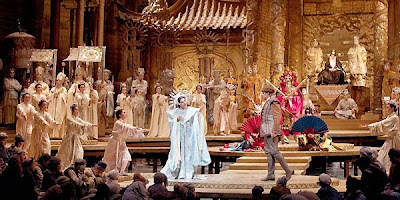The Metropolitan Opera's 1987 Franco Zeffirelli production of Turandot is one of the company's "big shows" with 286 people onstage and cruel demands on the singers. Zeffirelli's visions of ancient China include moving, shimmering golden sets, palaces rising on elevators and even a fake lake in the palace. It gets more complicated when you add all the "Zeffirelli extras": a chorus of little bald monks, a dancing dragon, kow-towing palace slave-girls and a beefcake executioner armed with a really big sword. But for once, it didn't look like a traffic jam in downtown Peking. After Monday night's performance, this Turandot is back in a big way, with a good singing cast and choreographed crowd control.
On a good night, Turandot is a competition between the three leads to steal the show. Last night, the clear winner was Maija Kovalevska as the suicidal slave-girl, Líu. This was a heart-rending (and potentially, star-making) performance, enough even to melt the frozen heart of a Chinese princess or any opera critic. She sang a beautiful, moving "Signor, ascolta" (complete with traditonal sobs at the end) and nailed the two Act III arias that make up her torture scenes.
Salvatore Licetra had a reasonable outing as Calaf. He has a pleasing ring of metal in his voice that enables him to (usually) get over the chorus and thundering orchestra. But he pulled sharp in his "Nessun Dorma" and failed to bring down the house with that most famous aria. By contrast, Maria Guleghina sang a strong "In Questa Reggia" but suffered from a wide (but not wobbling) vibrato in the Riddle Scene.
Guleghina was better in the third act, especially in the music written (by the composer Francisco Alfano) to complete the opera after Puccini's death. It didn't quite live up to Puccini's last written instruction ("Then, Tristan!") but this was an impressive performance of the opera's weakest section. Guleghina may not be a perfect Turandot, (there's been no such thing since Nilsson retired) but she convinced the audience that the ice princess has melted into a real flesh-and-blood woman, deeply in love with her prince. This is a near-impossible task (made more challenging by Puccini's death) and Guleghina pulled it off.
The real star of any Turandot is the orchestra and chorus, providing the mystique and the voice of legendary China, and a Mussorgsky-like commentary on the action. This is a big public opera with lots of difficult choral music and pseudo-Asian polyrhythms. Conductor Andris Nelsons led a nuanced, fairly slow performance, giving the singers room to breathe and drawing out hidden detail in Puccini's complicated score. The opening of Act II (the "Ping, Pang and Pong" scene) was especially beautiful, as Nelsons let the orchestra linger over the most sentimental moments. In the third act, the decision to move the offstage "palace brass" to the Family Circle boxes (instead of in the lighting bay above the auditorium) resulted in a sonic improvement.
Photo © 2009 Marty Sohl/The Metropolitan Opera





